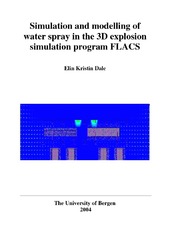Simulation and modelling of water spray in the 3D explosion simulation program FLACS
Master thesis
Permanent lenke
https://hdl.handle.net/1956/1326Utgivelsesdato
2004Metadata
Vis full innførselSamlinger
Sammendrag
In a gas processing plant and in offshore platforms a gas explosion could have serious consequences, and it is therefore essential to have mitigation systems that can prevent and/or reduce unwanted scenarios. One such mitigating technique that has proved to be effective is water spray and deluge systems. Since such systems often already are installed in most industries to use in a fire-situation, this has become an attractive method in fighting gas explosions. Experimental work has been done with the use of water spray, and the main results are that activation of water spray before an ignition can reduce rapid flame acceleration that otherwise could result in high-pressure build-up. Because the consequences of a gas explosion depends on many different parameters, a numerical model was developed that could handle different scenarios and give good results. The model was named FLACS (FLame ACceleration Simulator), and is a tree-dimensional gas explosion and gas-dispersing tool. FLACS is a Computational Fluid Dynamics (CDF) code. FLACS 2.2.5 (2001) is the current version, where the water spray is defined by a simplified box-model that assumes uniform parameters inside each box area. This model doesn’t include transport of droplets with the flow, reduction in burning velocity due to a temperature drop caused by the water spray, and turbulence and temperature changes due to break-up and evaporation of droplets. A new model, FLACS 2.2.6 (2004), is developed that takes into account the transport and break-up of droplets. An equation connecting the reduction in burning velocity to the amount of water spray over the amount of gas was therefore developed, and a setup file determining evaporation of droplets of different sizes was included to the model. This model is called FLACS 2.2.6*. Results from the simulations show that water spray will have the best mitigating effect: * In scenarios with sufficient ventilation openings and obstructions * When it is activated at the accelerating phase of the explosion * When the ignition occurs at the end of the cloud * When not activated only near ignition FLACS 2.2.5 does in most cases give a good representation of a real situation, but one weakness is that in scenarios where the water spray normally would be transported with the flow FLACS 2.2.5 has a tendency to under predicate the results. FLACS 2.2.6* without the setup-file gives a good representation of the explosion pressure with the explosion box, but does in most cases over predicate the time of arrival. The tendencies are although the same as in the experiments. FLACS 2.2.6* with the setup-file over predicates both the explosion pressure and the time of arrival. The deviations are probably because the flow doesn’t reach high enough values to fulfil the critical droplet velocity, and the evaporation and extraction of energy is thereby not effective. With the M24-25 module the results with the setup-file gives much better results. In this geometry the flow propagates over a larger distance, and thereby the break-up and evaporation of droplets will influence the results. A general source to deviation in the results is that the water spray is also exiting the nozzle as a narrow jet instead of a broad cone, as it would do in real life, and the lack of initial water spray turbulence gives a over predication in the time of arrival. A report written by DNV concerning a detailed probabilistic explosion analysis at Kårstø states that due to the high explosion loads that is calculated, it is recommended to consider mitigating measures [1]. Explosion simulations performed with the Kårstø geometry show that the explosion pressure is significantly reduced when water spray is activated at gas detection, if the water spray is located far from ignition or over a large area. The formation of a large flammable gas cloud and the spreading of gas to other areas would result in a stronger explosion and more serious consequences. Simulations were performed to investigate the effect of water spray on gas dispersion at the Kårstø facility. The water spray will have a negative effect on the gas dispersion because the activation of water spray will cause turbulence and then increased mixing of gas and air. The water spray will have a positive effect by limiting the spreading of the gas to other areas.
Utgiver
The University of BergenOpphavsrett
The authorCopyright the author. All rights reserved
